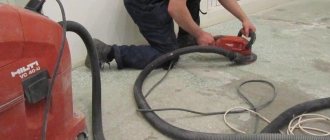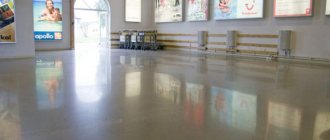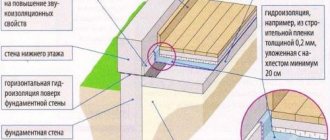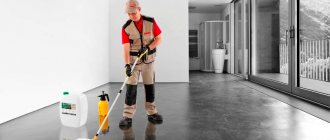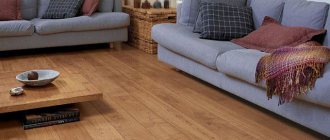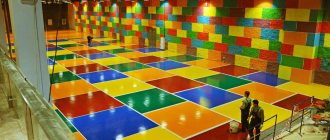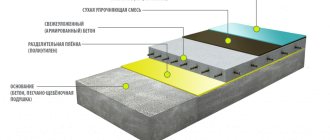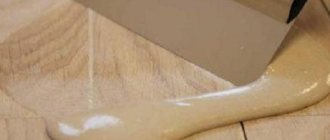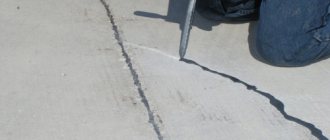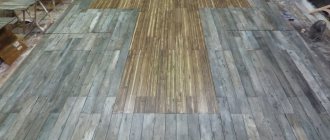Types and characteristics
A concrete trowel is a device of simple design: it consists of a drive, a gearbox, a frame, a blade (or two), operator protection and a control system. The surface is rubbed first with a disk that is put on the blades, and then with the blades themselves, which rotate at high speed.
According to the type of drive, a helicopter can be of the following types: diesel (quite rarely used), gasoline, electric. Fuel-powered devices are mobile and powerful; they can be used in open areas to process large surfaces, but require ventilation indoors. Electric machines can be used in enclosed spaces, but require the ability to connect to the network.
A helicopter for grinding a concrete floor can have a different diameter of the working disk, a different number of rotation speeds, and the angle of the blades can also be adjusted. All models differ in the length of the blades, engine power, and the method of interaction with the operator (a special place or device driven by a person can be equipped for him).
Depending on the number of blades, the units can be single-rotor (for roughing limited areas) or double-rotor (usually self-propelled, high-performance and large-sized).
When grinding concrete by helicopter is necessary, when choosing a machine you need to pay attention to the parameters of the unit. Thus, the intensity of the impact on the treated surface depends on the range of rotation
For rough and finishing processing, a unit with a rotation speed of at least 200 rpm is suitable. It is desirable that the rotation speed be regulated.
Diameter is an indicator that indicates the performance of the equipment and the level of maneuverability. If grouting a concrete floor with a helicopter will be carried out in a small room or on shaped areas where there are narrow passages, it is better to choose a diameter of 610 millimeters. When you need fast and effective grouting of a large area, you can take 900 millimeters or more.
Single-rotor
A single-rotor concrete trowel (helicopter) is used to process not very large areas - on average up to 500 square meters. Models can be equipped with a gasoline or electric drive, with one blade with a diameter of up to 1.2 meters. It is possible to adjust the force and speed of rotation.
The unit is controlled by an elongated handle with buttons and levers (the machine is driven by an employee). Such units are characterized by mobility, versatility, light weight, compactness and ease of use.
Double rotor
A two-rotor trowel (helicopter) already belongs to the class of professional equipment, used for processing surfaces of 500 square meters or more. A large-sized productive self-propelled machine can only work in large spaces, without any obstacles or changes in surface configuration.
Models are usually equipped with two troweling blades, the diameter of which is in the range of 600-1200 millimeters. Typically, units run on gasoline or electricity (diesel fuel is rarely used at all, since the operation of the machine is no different from gasoline and this choice is relevant only for those who have free access to diesel fuel).
The devices are controlled by an operator who can sit low or high, usually between the rotors in a special chair. Operates levers, buttons, or joysticks.
Machines and production process
What is topping
This is what the floor looks like after topping
In construction, topping is a mixture that is used to cover concrete areas to make the flooring of an apartment or house more durable. It is based on cement with various impurities, which may contain metal particles, corundum or quartz.
To increase wear resistance at high loads, additives from corundum materials are used, and at very high loads, metal particles are used. Quartz is used under medium loads, for example, in public buildings or even in production workshops using light vehicles such as forklifts and trucks.
Of course, the price of a concrete floor with a strengthening coating will be slightly higher, but in this case you protect the base from destruction, which is facilitated by external factors such as temperature changes, moisture and mechanical loads.
Let's take a closer look at the benefits and advantages that you gain thanks to this processing:
- Thanks to the impact resistance, there are no cracks, chips or other mechanical damage on the surface, even with strong impacts.
- Wear resistance increases significantly, which, in turn, increases the service life of the entire structure.
- The topping is absolutely neutral to all chemically active substances, which means it can be used in workshops with chemical products.
- This floor has antistatic properties and also completely eliminates the generation of dust.
- The structure of the coating can be grainy, smooth and shiny - this allows you to decorate it at your discretion.
Grinding and topping machines
Manual topping trolley TREMIX 830
- The principle of operation of such a cart, which you see in the photo above, is to distribute the strengthening mixture over the concrete floor. To load powder material, there is a hopper, which is closed along the entire length from below with a shutter. This damper can be opened using the lever of a rotating crossbar, which is connected to it by rods.
- To change the degree of opening of the damper, you need to reinstall a special stop bar, which, in turn, is fixed with a screw handle. The action occurs as follows: after opening the valve, the operator begins to push the cart at one speed or another, which sets the drum inside the hopper in motion. During rotation, the drum pushes the topping through the damper and it evenly falls on the concrete surface (only one operator is required to operate such a unit).
Concrete floor grinding technology: preparatory work
Before you begin processing the concrete surface, you need to carry out appropriate preparation. The stage preceding the initial grinding includes several important procedures. The first thing to do is check the floor for cracks, unevenness and other defects. In case of serious changes in height, this flaw must be removed.
Then you need to tap the surface of the concrete. This procedure allows you to determine the strength and stability of the coating. During tapping, subsidence of the coating may be detected. If there is such a problem, the base will need to be refilled, which will greatly affect the final price. The floor should be sanded only after checking the electrical network in the room. Devices used to process concrete surfaces require uninterrupted power.
It is also worth mentioning that home craftsmen often do not pay attention to the seams that are located between the coating and the baseboards. If such gaps are found, they must be covered with a solution. Building codes and regulations contain a clause that prohibits grinding work if there are such gaps.
Preparatory procedures are very important, since the durability of the coating depends on them
It is possible to carry out such work on your own, but not everyone can do it. You can always use the services of specialists, but first it is recommended to determine the cost of sanding the floor. The price per square meter in this case is multiplied by the total area of the room.
You should also check the hardness of the coating in advance. It won't be difficult to do this. All that is needed to perform such a test is to sand a small area of the floor and evaluate the final result.
Sander
This device is connected to the vacuum cleaner with a powerful hose and this is very important for the surrounding area and the master. At the initial stage of grinding, diamond segments on a metal bond with a grain size of 6-30 microns are used. This degree of grinding removes not only a layer of cement laitance, but also exposes large aggregate – marble chips or crushed stone.
If you only need to polish the top sand-cement layer, for example, a new concrete screed, then grinding can begin with a disk with a grain size of 70 microns.
But if you are repairing an old coating, you must first repair cracks, potholes, and chips with a special high-quality repair compound - quick-hardening glue.
It fills all the unevenness and cracks, when it sets, you can start sanding. It should be noted that the higher the quality of the concrete coating, the better the gloss of the surface.
After the first two stages - rough grinding (3 - 70 microns) and filling potholes with an adhesive repair compound, proceed to the third stage - preliminary grinding with diamond segments on a metal bond with a grain size of up to 70 - 120 microns and treating the floor with a hardener. Hardeners are chemicals that are applied to dry concrete surfaces and react with the components of the concrete mixture to create a durable protective layer. Such surfaces do not generate dust, withstand dynamic loads, and are resistant to aggressive substances.
And finally, the final stage is polishing the floor with segments on a plastic bond with a grain size of 400 to 800 microns. This scheme for processing a concrete floor allows you to achieve an excellent result - a durable surface with a slight shine on the surface. But for perfectionists, it is possible to carry out an additional polishing stage with diamond coating from 1500 microns to 3000 microns. This polishing is admirable.
When concrete is polished with professional machines, they have, among other disadvantages, the following: not all places can be reached. There are spaces where the grinding wheel cannot reach due to its large diameter. For example, in corners or near door thresholds and window frames. Then you need to use hand grinders, so we’ll talk about them.
Step-by-step instructions for sanding
At the top of the concrete covering there may be reinforcement or a metal network. In this case, it makes no sense to carry out grinding, since the equipment will become unusable. You can remove the fittings using a grinder. At the initial stage of grinding, the coating is leveled. There are several ways to do this job:
- using milling;
- shot blasting method;
- Bulgarian
Preparation of the base is the most important step in constructing a concrete floor.
Most often, home craftsmen use a grinder to level the surface. It should be remembered that such work is performed with special diamond-coated tips, the grain size of which is from 25 to 30 microns. If you order such work from craftsmen, you will have to pay quite a significant amount, which is calculated taking into account the scraping. The price of sanding the floor yourself is determined solely by the cost of the equipment.
The next stage is the removal of minor defects. Epoxy-based materials are widely used for this operation. Their use allows you to easily fill small cracks and holes.
Only after this is it allowed to start sanding the floor with a grinding machine. The price of the work includes the cost of various impregnations and finishing coating (if available).
The price of sanding your own floor is determined solely by the cost of the equipment.
For direct grinding, a cutting element coated with diamond coating is most often used. The grain size of the disc should be 40 microns. The work is being done gradually. To obtain a perfectly smooth surface, you can additionally polish the floor using a material with a grain size of 1500-3000. The final stage is installation of skirting boards and varnishing (if necessary).
Instructions on how to grind a concrete floor
Grinding a concrete floor is carried out not only to obtain a perfectly flat surface, but also to obtain more durable qualities of concrete and increase its service life. In addition, grinding guarantees excellent hygienic conditions in the future and reduces the number of repairs. You can find an overview of types of paint for concrete floors here.
Peculiarities
Honed concrete floors have a lot of polarity these days, along with other flooring surfaces. The hype around them is due to their practicality, versatility and beauty, and they do not require any special care. The main advantages of polished concrete floors include:
- multifunctional application;
- environmentally friendly material;
- long service life;
- high-strength material, resistant to any external influences and loads;
- not afraid of water and other aggressive liquids;
- Thanks to the many finishing options for polished concrete floors, they can be used in any interior.
Equipment for grinding
You can level and sand the floor using both professional and household equipment. Grinding a concrete floor with a grinder is usually carried out using a dry method, since it is necessary to uniformly moisten the polished surface at the moment.
If water is supplied not using special devices built into the grinding machine, but manually, then any household tool can burn out.
Floor sanding helicopter
One of the most popular devices used to grout and level a concrete floor with your own hands is a “helicopter”. The powerful device received this popular name thanks to grinding elements arranged in the form of blades.
Work using a “helicopter” can be carried out immediately after the concrete screed has set. When performing “helicopter” grinding, it is necessary to immediately rub special polymer or wax additives into the coating, which protect the top layer from atmospheric influences. The grinding process is carried out in 2 stages:
- Abrasive attachments are put on the blades, and the processing process occurs at low speed.
- The next stage of grinding occurs at high speed directly with the blades.
It is advisable to carry out grinding work using a “helicopter” over large areas. To learn how to do the work yourself, watch this video:
Otherwise, during operation, the blades of the unit may break and destroy the top layer of coating.
Professional trowel
A professional device for grinding concrete surfaces has a rather complex design.
The machine is equipped with special fixing devices for abrasive discs (their number, depending on the size of the device, can vary from 1 to 5).
This unit wipes down floors very quickly.
The unit provides high-quality grouting at high speed, so if you are wondering how to level a concrete floor from minor flaws, this device will do the job perfectly.
The machine includes: a water supply device, a powerful vacuum cleaner and an automatic speed controller, with which the speed of the disks in various hard-to-reach places is regulated (so as not to remove excess).
Grinder processing
A grinder is a hand-held grinding device that is used at home.
It can be used to process small surfaces of concrete flooring.
The work must be carried out very carefully, as excessive pressure can damage the surface.
A 400 grit disc is suitable for sanding.
The technology for carrying out the work requires the fulfillment of certain requirements:
- before leveling the concrete floor to a glossy state, you need to put a 400-grit disc on the grinder;
- all sanded areas must be quickly and efficiently coated with polymer varnish within an hour after work to create a protective layer;
- Having your own tool, you need to learn to feel it in order to prevent (at the time of processing) the creation of depressions larger than 20 mm. For more information about grinding concrete with a grinder, watch this video:
Some nozzle options and their characteristics can be seen in the table.
Grinding a concrete surface is a rather careful job, so to carry out a high-quality process over large areas, it is better to invite professionals with the appropriate equipment. If the dimensions of the concrete screed are small, then you can take on the work yourself, using a grinder and following the above recommendations.
Sanding concrete floor
The rapid development of supermarket chains, hotels, restaurants, salons, office and shopping centers, and exhibition halls creates a demand for durable, abrasion-resistant, dust-free and non-staining beautiful floor coverings. One such coating is a polished concrete floor. Only high-quality surface treatment turns ordinary concrete into a durable and effective base that can withstand heavy loads, be easy to clean and decorate the interior.
Why does concrete need to be polished?
When creating a solid foundation, concrete is indispensable, but during the process of hardening, the surface is not as strong as we would like. Therefore, for subsequent processing it is necessary to remove the top layer formed during the stratification of the solution (“cement laitance”), which very quickly collapses and turns into dust. On old concrete bases, the top layer loses its integrity during use and becomes uneven, with potholes and cracks, often in old stains. A concrete grinder is used for this.
Applying special impregnations to a rough-polished surface makes the concrete stronger, removes the cause of cement dust, increases surface adhesion and prevents moisture absorption. Grinding is mandatory for installing self-leveling floors or mirror polishing.
Grinding Methods
Grinding concrete surfaces is one of the stages of finishing construction work, which includes bringing the base to finishing.
The decorative effect of a concrete floor depends on the aggregate of the concrete mixture
Any concrete can be polished, but the result will depend on the brand of concrete and fillers. For production purposes (flooring in workshops, garages, warehouses), concrete grades from M150 to M300 are usually used, and fine crushed stone is used as filler. For flooring in public buildings, where a more refined appearance is required, granite crushed stone or marble chips are used as filler, which after processing gives it originality. The grinding machine removes the concrete layer down to the filler, and the applied layer of colorless impregnation will allow you to see the pattern of stones.
Technological stages of grinding
To obtain high-quality polished concrete, immediately after pouring the screed and compacting it, waiting until you can walk on it carefully (6-8 hours after laying), carry out the leveling and smoothing procedure. For this purpose, troweling or smoothing machines (sanding helicopter) are used.
Construction helicopters have trowelling discs and smoothing blades. For small volumes, manual electric trowels are used, and for large areas it is more profitable to use single-rotor or double-rotor gasoline trowels, which also have large diameters of disks and blades and allow simultaneous processing of a large surface. The use of this technology even at the concrete setting stage eliminates unevenness, prevents premature deterioration (crumble) of the surface layer, and also prepares the basis for the first stage of grinding.
The first (pre-grinding) is carried out within a week after laying the concrete, and the main finishing process begins only after the concrete has gained strength, that is, after 28 days, using special diamond grinding cups for concrete.
The actual grinding stages are considered several, depending on the requirements for the appearance of the finishing coating; the price of the work performed often depends on this. So, to create a solid foundation in a workshop or warehouse, you can limit yourself to three stages:
- rough grinding with double-row coarse-grained cups until maximum exposure of filler grains (from 4 to 7 mm);
- applying impregnations (strengthening solutions are applied until the concrete is completely saturated, but so that no puddles remain);
- finishing with turbo or boomerang diamond cups with fine grit, imparting hardness and shine to the surface.
To ensure that there is less dust in the room using the dry method, a vacuum cleaner is connected to the grinder.
After these operations, polished concrete is suitable for use and does not require further polishing. You can additionally protect the surface by painting it or varnishing it.
In those rooms where increased demands are placed on the appearance of the floor, several more stages of finishing work are carried out.
Concrete grinding can be done using a dry or wet method. In principle, any concrete floor grinder is equipped with devices for dust removal and water supply. Wet grinding is always more expensive; it is used mainly for processing mosaic floors or coatings with marble chips.
Grinding devices
Many companies offer professional grinding equipment. The market offers equipment of various classes from Blastrac (Netherlands), DIAMATIC (Belgium), Schwamborn (Germany), Klindex (Italy), Husqvarna (Sweden), Splitstone (Russia) and Miesom (Belarus).
Self-respecting companies mainly use equipment from Klindex, which has been a European leader for more than a quarter of a century. The cost of small machines ranges around 1,000 euros; machines from domestic manufacturers are also in the same price category; only Chinese-made equipment can be purchased at lower prices. Professional grinders are placed in the price category of 3,000 euros and above.
Professional grinders with planetary mechanism
The main advantages of professional devices are efficiency and productivity. For example, a mosaic concrete grinder is equipped with a planetary mechanism, where a large disk rotates in one direction, and surfaces with diamond bowls rotate in the opposite direction. This system provides the most even and smooth surface.
Such units operate with regulation of speed, water supply, and provide removal of dust and sludge. The weight of the machine directly affects the quality of grinding; heavier machines work more efficiently.
Installing beautiful polished concrete floors is also possible at home. Do-it-yourself grinding of a concrete floor can be done using a regular grinder, for which you purchase a diamond tool. This is a labor-intensive and dusty process, so you need to use protective equipment (respirator and goggles), but the result will justify the time and labor spent. Such floors are practically eternal.
Diamond tool
For grinding and polishing work on concrete, diamond tools are used: cutters, discs, Frankfurts, cups. They can have a different number of diamond segments, very different shapes and grain sizes. To optimally select the required size of diamond cups, several factors are taken into account:
- what kind of grinding equipment is used (power);
- age and condition of concrete;
- concrete grade and filler.
Diamond grinding of concrete allows you to achieve a variety of effects in floor design. It can make the floor mirror or have a wet stone effect; it can be decorated with designs and painted in different colors. Such a floor is antistatic, resistant to any chemical influences, dampens vibration, there are no traces of rubber left on it, and the achieved homogeneity reduces vibration and leaves no traces of rubber.
The ideal tool for both removing thick layers of concrete and bringing it to a mirror finish is a diamond grinding cup. These discs are cup-shaped with diameters ranging from 95 to 180 mm and a standard bore size. All are equipped with an adapter ring, which allows them to be installed on any type of machine. Each type of work has its own bowl design. An incorrectly selected tool can lead to increased costs.
The market offers a wide range, including diamond bowls from the world brands Solga Diamant, Sidamo, Nam Soo and Workdiamond. The cost for professional machines (depending on the manufacturer) is from 1,300 rubles to 7,500. For home devices there are cheaper ones starting from 350 rubles.
Price policy
If you plan to involve professionals in finishing concrete work, then the price of polishing a concrete floor is calculated based on the number of operations required. Thus, average prices per square meter of area when leveling a concrete base start from 500 rubles, rough grinding - from 140, grinding high-strength concrete - from 180, finishing grinding with fine-grained nozzles - from 90, polishing work - from 120 rubles.
stoneguru.ru
Grouting concrete is the key to perfectly smooth and wear-resistant floors
For mechanical smoothing and grouting of freshly laid concrete floors, special smoothing machines are used, which are also called “helicopters” for their peculiar appearance, somewhat reminiscent of rotating helicopter blades. It is no secret that concrete floors are usually laid in parking lots, garages, warehouses and industrial premises, i.e. where great wear resistance of floor coverings and unpretentiousness during their operation are of great importance. Of course, a concrete floor is practical, but not everyone is satisfied with just practicality, some want variety, and in this case, troweling machines are used for smoothing gypsum and cement-sand screeds, under floor coverings such as PVC tiles, linoleum, carpet, etc.
Smoothing and troweling are two sequential concrete finishing processes performed by one tool - a troweling machine - and both processes are used to produce a smooth surface at the final stage of concrete processing to make the top layer of the concrete floor smooth and wear-resistant. Moreover, a trowel is necessary when using the technology of rubbing special dry compacting mixtures (toppings) into the surface of freshly laid concrete, which increase strength, wear resistance, impact resistance and can give the coating an aesthetic appearance.
Processing sequence:
Treating the concrete surface with a trowel, an excellent option is the Tremix G Combi E855 concrete trowel, is carried out after the work of laying, compacting and leveling the concrete mixture has already been completed.
Do not forget that after working with the concrete mixture and before troweling the concrete surface, it is necessary to take a technological break so that the concrete can gain initial strength. Depending on the humidity and ambient temperature, this break ranges from 3 to 7 hours. During this time, the concrete sets in such a way that an adult who is not overweight and does not sway from side to side from a light breeze, stepping on its surface, leaves a mark 3-4 mm deep. During this period, you need to start rough grouting the surface.
Concrete adjacent to structures, columns, pits, doorways and walls should be treated first, as it hardens faster in these areas than in the rest of the area. Rough grinding of the surface of freshly laid concrete is carried out with a disk or floating blades.
When using a dry surface sealant (topping), it is carefully scattered over the surface of the screed, trying to achieve a uniform layer thickness. Topping consumption during the first application is about 2/3 of the total volume. After applying the topping, the first rough grouting is carried out; the Masalta MT36-4 concrete smoothing machine is perfect for this. Grouting must be done as soon as the topping absorbs moisture from the concrete (the surface will darken). Grouting should be done with a disk or floating blades.
After completing the first rough grout, you should immediately add the remaining 1/3 of the topping so that it has time to become saturated with moisture before the water evaporates.
After the mixture is saturated with moisture (the surface darkens), immediately proceed to the second rough grout.
During rough grouting, the strength of concrete gradually increases. At the moment when a person’s foot leaves a mark on the concrete about 1 mm deep, you need to start finishing grouting.
The final grouting is carried out using the finishing blades of trowels.
nskprokat.ru
This is interesting: Installation of a protective layer of concrete for reinforcement - a general view
- Concrete floor without dust, grinding, grouting concrete by helicopter ⌚ — 2020-05-22 at 21:35:54Z
- Grinding concrete with a helicopter, Leveling the screed! How to level a concrete surface ⌚ — 2019-12-28 at 09:51:29Z
- Grouting concrete by helicopter!!! ⌚ — 2019-12-26 at 12:40:45Z
- How to concrete floors in a garage Grinding concrete Mirror concrete floor ⌚ — 2019-11-27 at 04:00:03Z
- Laying and Grouting Helicopter sanding of 200 sq m of floors using liquid beacons under ,,The Prodigy ⌚ — 2019-07-02 at 10:03:23Z
- Grinding concrete! Monolithic slab! ⌚ — 2019-06-13 at 14:05:46Z
- How not to grind concrete with a helicopter. ⌚ — 2019-03-23 at 05:24:05Z
- Concrete floor without dust video. Concrete grinding. Mirror concrete floor. How to make a topping floor ⌚ — 2019-01-29 at 09:04:51Z
- Grinding a concrete floor screed by helicopter ⌚ — 2018-10-12 at 14:47:12Z
- Repair of concrete floors, topping repair Polishing system for power trowel ⌚ — 2018-10-07 at 18:30:26Z
- First grouting of concrete by helicopter. Concrete floor - topping. ⌚ — 2018-09-24 at 06:44:04Z
- Grinding a concrete floor by helicopter ⌚ — 2018-08-23 at 18:21:59Z
- Grinding concrete by helicopter ⌚ — 2018-07-31 at 15:25:47Z
- Grinding concrete by helicopter ⌚ — 2018-06-16 at 04:12:58Z
- Grinding concrete by helicopter ⌚ — 2018-06-16 at 04:11:50Z
- Grinding concrete by helicopter ⌚ — 2018-06-16 at 04:10:44Z
- Grinding concrete by helicopter ⌚ — 2018-06-16 at 04:09:50Z
- Grinding concrete by helicopter ⌚ — 2018-06-16 at 04:08:45Z
- Grinding concrete by helicopter ⌚ — 2018-06-16 at 04:07:32Z
- Grinding concrete with topping. By helicopters ⌚ — 2018-06-15 at 13:42:18Z
- Grouting concrete by helicopter ⌚ — 2018-06-07 at 09:53:40Z
- Grinding concrete with a helicopter trowel ⌚ — 2018-01-12 at 17:13:04Z
- Israel How I Worked. Grinding Concrete by Helicopter # 9 ⌚ — 2017-10-29 at 17:32:54Z
- Concrete grinding. Smooth concrete floor. VSAMAREPOL.RU ⌚ — 2017-07-23 at 14:50:41Z
- Grouting concrete by helicopter ⌚ — 2017-04-29 at 09:02:01Z
- Fighting a helicopter ⌚ — 2016-04-14 at 17:59:34Z
- Grinding a concrete floor with a helicopter ⌚ — 2015-10-06 at 14:58:24Z
- Grinding a concrete floor with a helicopter ⌚ — 2015-09-28 at 19:00:28Z
- Troweling machine for grinding concrete Honda 600 helicopter Sale of troweling machines inexpensively ⌚ — 2015-08-01 at 08:33:42Z
- Grinding concrete with a helicopter 2! ⌚ — 2015-05-23 at 16:04:15Z
- Grinding concrete with a helicopter! ⌚ — 2015-05-23 at 15:42:50Z
- Self-leveling floor. Concrete grinding. ⌚ — 2015-04-16 at 11:13:05Z
- Grinding a concrete floor with a helicopter ⌚ — 2014-11-26 at 04:24:25Z
- Technology for the construction of industrial concrete floors. WACKER NEUSON equipment. SDM-Hydraulics. ⌚ — 2014-10-29 at 12:01:33Z
- Sanding the floor with a helicopter ⌚ — 2014-02-08 at 19:34:30Z
- Wet grinding of concrete.AVI ⌚ — 2012-05-06 at 20:45:33Z
More video
Tags:
By date: 07/13/2020 - 07/14/2020 - 07/15/2020
Commented video:
A one-legged brawler destroyed a grocery store in Ryazan. Video - Russia 24
⇒ “The incident is truly extremely terrible and cruel, the man, instead of asking for help from the store employees, began to organize a concert for the public.
He began to destroy everything around, destroying the goods that the workers had been storing all night. So that everything is ready in the morning, for such ... " View in full... Added - 07/14/2020 FNAF Tower Defense
⇒ "I highly recommend it to everyone" View in full... Added - 07/14/2020
VICTORY PARADE // 2018
⇒ "remember" See in full... Added - 07/14/2020
Assassin parkour to the song bada-boom
⇒ “LOL” Watch in full... Added - 07/14/2020
GTA: Criminal Russia (Online) #1 - The beginning!
⇒ “tiroma” View in full... Added - 07/14/2020
Lesson 1.1: General provisions of traffic rules, a complete video course of traffic rules in simple human language (2017-2018)
⇒ "download traffic rules" Watch in full... Added - 07/14/2020
Purpose of trowels
The concrete screed after exposure to vibration equipment and initial setting needs to be promptly brought to a state ready for use. Troweling machines (helicopters), having different characteristics and performance, are used on objects of any size: from apartments to giant terminals. Such equipment solves the only problem - the formation in a short time of absolutely flat, perfectly smooth dust-free floors by machine compaction of the concrete surface. This grinding of horizontal concrete surfaces is effective and cost-effective.
Grinding concrete using a helicopter
This type of grinding is mainly used when leveling large areas of the surface:
- in hangars;
- large commercial warehouses;
- in shopping centers;
The unit that directly performs the work itself is a machine controlled by the operator. Its front part has a large rotating disk. Auxiliary wheels moving in one direction are attached to it. They are equipped with diamond attachments that directly grind the surface of the concrete to form a perfectly smooth layer.
Before starting work, you need to make sure that there is no reinforcement or metal mesh in the concrete. An unprofessional approach to work can result not only from the breakdown of the “helicopter,” but also from the destruction of the concrete surface itself.
The grinding process is carried out only 2-3 weeks after the screed has dried. During this time, the coating acquires the necessary strength and is ready for subsequent processing.
There are two types of grinding:
- Dry. Its advantages are that the master can constantly monitor the result of the work and correct shortcomings at any time, despite the large dust that is raised due to the action of the “helicopter”. This dust can be easily removed with a special industrial vacuum cleaner.
- Wet. The result obtained after processing is no different from dry grinding, however, instead of dust, wet cement sludge constantly flies in the air, which reduces visibility and control over the work. Wet cement is removed using a water pump.
In practice, it was noted that machines with large weight and size have a great advantage over compact, small-sized devices, the result is obvious.
Safety precautions
When using special equipment to grout a concrete floor, it is imperative to follow the safety rules:
- Constantly check the engine heating level, carbon monoxide emissions, and noise levels.
- Be aware of possible burns from alkalis contained in concrete and toxic fumes from fuel.
- Be aware of the fire hazard.
The operator must have personal protection in the form of overalls, safety glasses, earplugs, and closed-type shoes. There must be protective shields on the machine body. The mechanism should not be operated if the engine is not operating properly.
Preparation
In order for polished concrete to last a long time, its proper preparation plays an important role. To do this, you need to take the following steps. First of all, dismantle the old coatings and check the evenness of the plane with a three-meter ruler. The presence of holes, potholes or bumps determines the degree of cup wear. Then you need to examine the surface for the size of cracks, seams, etc. If available, seal them with any hand tool.
Before starting sanding work, you also need to tap the floor or walls for strength. If it is missing, some areas will have to be refilled. At the same stage, complex work is performed, for example, diamond drilling of concrete
It is important to ensure the reliability of the power supply - any interruptions can have a detrimental effect on the outcome of the process
Important criteria in assessing the readiness of a floor for sanding are the absence of cracks, seams and other elements that could damage the delicate sanding tool.
Types and description of the unit
Concrete pouring, after compaction with vibration installations and initial drying, requires urgent bringing its surface to condition. Concrete trowels are available in various modifications, which differ in technical characteristics and performance. Such units are used to process various objects - from an individual home to a huge passenger terminal. Processing concrete surfaces using a mechanized method is a highly effective and cost-effective measure.
The power plant of a power trowel can be of several types: electric motor, diesel, gasoline.
The “helicopter” for grouting concrete has the following device:
- frame platform;
- power plant (gasoline, diesel, electric motors);
- gear unit;
- blade working mechanism;
- protective casing;
- control mechanisms.
Depending on the working mechanism, the machines come in single- and double-rotor types. The first type is used for small amounts of work. Units with two rotors are used over large processing areas. Devices for grouting concrete are equipped with a rotary speed switch for the working parts, which is necessary for intensive impact on the monolith during 2-time processing. The grip of the blades and the power of the power plant are the parameters that determine the performance and maneuverability of the machine. The single-rotor kromnik mechanism with a working grip of 600 mm specializes in grouting hard-to-reach surfaces near walls, columns, and door openings.
Single rotor unit
Grouting of concrete with a “helicopter” of this type is carried out on structures under construction with a grinding area of up to 0.5 thousand m2. Machines of this type are equipped with a gasoline or electric power plant with one working element, with a grip of up to 120 cm. When grouting, the speed of movement of the unit and the rotation force of the blades are adjusted. The operator regulates the work process with his own hands through the control panel with levers and buttons. A “helicopter” with one rotor is characterized by mobility, versatility, compactness, and low weight.
Double rotor machine
The two-rotor machine is used on construction sites whose dimensions exceed 0.7 thousand square meters.
A device for professional use in construction processes on areas larger than 0.7 thousand m2. This is a self-propelled, high-performance machine with large dimensions, equipped with 2 troweling blades with a cross-section from 60 to 120 cm. It is equipped with electric or liquid fuel engines. There is a line of devices that are equipped with hydraulics, and their movement is controlled by joysticks. The operator's position is a chair located between the rotary units. Devices are available with high and low placement above the level of the surface being treated.
Color palette:
*Colors presented on the website are for informational purposes only. We recommend choosing the color of the product you are interested in using samples.
*Exhibition samples of colored masonry mixture are indicative only. The final appearance of the finished wall depends on a number of factors: the temperature and humidity conditions of the environment during the work, the quality of the water used for mixing the mixture, following the manufacturer’s recommendations and adding various impurities when preparing the solution, compliance with the jointing technology and tool requirements, care conditions behind freshly laid masonry.
Color article table:
| vendor code | Color |
| x405 | white |
| x410 | grey |
| x415 | dark grey |
| x420 | beige |
| x436 | mustard |
| x437 | copper |
| x438 | brick |
| x440 | cream |
| x445 | light brown |
| x450 | brown |
| x455 | chocolate |
| x465 | black |
Mode of application:
Mix the mixture with ~ 5.5 liters of water (per 25 kg of mixture) and mix vigorously using an electric drill with a stirrer until a working fluid consistency without lumps is achieved. Using a rubber spatula, fill the joints with mortar diagonally to the joints under slight pressure, ensuring they are filled deeply and tightly. Do not allow a large amount of solution to come into contact with the front surfaces of the slabs, otherwise cleaning the slabs will be difficult. It is recommended to use a bag or a syringe gun.
A white coating may appear on the paving stones: to achieve optimal results, it is recommended to test the solution on a separate area of the paving stone surface.
Depending on the absorbent properties and surface structure of the paving stones, the following methods for cleaning them are suggested below:
- Cleaning with water jet:
Immediately after the surface of the joints has hardened, the paving stones should be cleaned. The hardening of the seams is checked by touch. Drying time can range from 1 to 3 hours.Clean the surface with a stream of water from a spray bottle and a stiff brush diagonally towards the seams. In this case, do not allow the solution to be washed out of the seams. Possible leaching of the solution means that the required stage of hardening has not yet been reached. Repeat cleaning until the surface is completely clean.
- Rinse with water:
Immediately after the surface of the joints has set, the paving stones should be cleaned. The adhesion of the seams is checked by touch. Drying time can range from 1 to 3 hours. Clean the surface using a board with a sponge diagonally to the seams.In this case, do not allow the solution to be washed out of the seams. If the solution is washed out, this means that the required stage of hardening has not yet been reached. Cleaning water should be changed regularly. Repeat cleaning until the surface is completely clean.
Mixture consumption: Depending on the format of the paving stones, as well as the depth and width of the joint. On average 5-10 kg/m2 with a joint width of 5 mm.
Packaging and storage:
25 kg paper craft bags. Shelf life - 12 months from the date of manufacture indicated on the packaging, in undamaged original packaging, avoiding moisture and sudden temperature changes in covered dry warehouses (air humidity no more than 60%) rooms.
Security measures:
Do not let the dry mixture get into your eyes. In case of contact, rinse the affected area thoroughly with running water and consult a doctor if necessary. Wear goggles and protective clothing when working.
How to choose a trowel
When choosing grinding machines, you should focus on several basic parameters: the availability of the model and the feasibility of financial costs, the size of the area and the presence (absence) of obstacles on it, the frequency of operation of the unit. A concrete grinder (helicopter) may differ in engine type, power, and working width.
The type of engine has virtually no effect on the quality of work, but it does affect comfort and the ability to perform work. Fuel drives are used in open areas, electric drives are used in enclosed spaces of various sizes.
Single-rotor machines with one blade from 30 to 61 centimeters are best chosen for small spaces with hard-to-reach areas. Double-rotor machines are more suitable for large-scale work. Machines with a blade diameter of 90 centimeters are considered universal.
The diameter of the smoothing blades determines the working width - that is, it directly affects the productivity of the equipment. Serious work is performed with nozzles up to 1.2 meters. The rotation speed must be changed. Both stages of processing (rough grouting and final polishing) can be carried out by a machine with a rotation speed of approximately 200 rpm.
Helicopter for grinding concrete floor
For finishing grinding and removing irregularities, hand tools are used. The operating principle of the grinder is that its disk-blade part rotates at a certain speed in a vertical plane, as a result of which the top layer is rubbed into the thickness of the concrete and leveled. Two gearboxes with attached trowelling discs are driven by a belt drive mounted on the motor.
During operation, the angle of the blades is adjusted, which allows you to obtain high quality results and a beautiful glossy surface. Such installations are self-propelled; the working width of some models is from cm or more. The car engine is started using the key on the control panel. To achieve maximum processing quality, it is necessary to strictly adhere to the technology. The surface should be sanded for the first time at least three hours after pouring the concrete mixture.
The final grouting is carried out ten hours after rough sanding. The procedure itself is carried out in stages:
Technologically, smoothing concrete by helicopter looks like this: The technology for processing concrete with a grinder is affordable and the most effective.
Polishing concrete floor
Polishing of the concrete base is carried out upon completion of grinding work. This procedure allows you to achieve a durable, shiny, smooth coating that can be put into use immediately after the polishing process is completed.
As a general rule, concrete polishing should only begin when all grinding work has been completed.
Polishing is carried out with special diamond discs with segments with a grain size of more than 1500. At the same time, the grain size of the segments and the number of treatments depends on the tasks: the coating can be made either matte or mirror-glossy.
The disadvantage of the event is that polishing concrete increases the cost of repair work. But the money spent on the services of professional workers, the purchase or rental of special equipment will be more than recouped by the performance characteristics of the coating.
At the same time, due to their smoothness, polished floors are much easier to care for than porous surfaces that easily absorb dirt and dust.
Grouting cracks in concrete
The appearance of cracks in concrete floors is a sure sign that the load-bearing capacity of the structure is decreasing. Regardless of the cause and source of cracks on the floor surface, repair work must be carried out to stop the growth of cracks and prevent the entry of moisture, debris and other particles. For such damage to concrete, manual methods can be used. However, the method should be selected depending on the size of the damage and the cause of its occurrence:
- Cracks up to 1 mm wide, which formed under the influence of time and temperature, can be repaired using hard coatings. These are polymer, water-cement mixtures, as well as compositions based on synthetic resins.
- For a small number of cracks up to 2 mm in size, paint or polymer cement paste is used.
- If there are a large number of cracks, grouting is not advisable. To eliminate them, you need to use polymer cement solutions.
- When cracks and large gaps form in concrete structures under the influence of aggressive environmental factors, you can use the injection method; polymer cement mortar and paint are suitable for the job.
- Shotcrete is considered an effective method.
- Damage and cracks larger than 3 mm must be repaired with epoxy glue, some with cement filler.
- Very wide gaps are first reinforced with metal brackets.
List of sources
- tehno-beton.ru
- DekorMyHome.ru
- kladembeton.ru
- remoo.ru
- 1beton.info
- garantspb.com
- ZnayBeton.ru
- svoi-pol.ru
- td-perel.ru
- GuruPola.ru
- Author: Sergey
Share with your friends!
